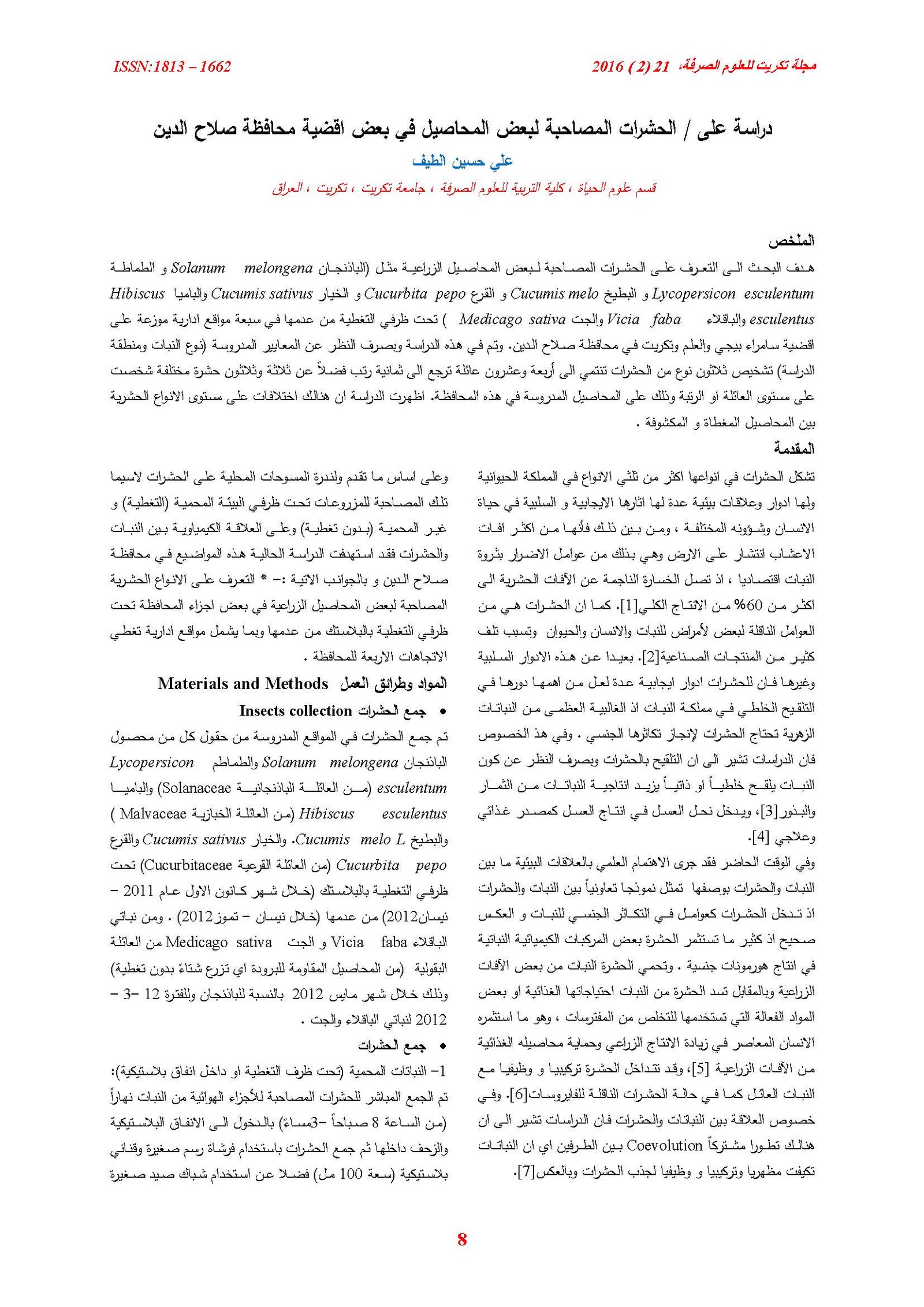Insects associated with some crop in some districts of Salahaldin Governorate
Main Article Content
Abstract
The study aimed to identify the insects associated with some agricultural crops (Solanum melongena Lycopersicon esculentum Cucumis melo Cucurbita pepo Cucumis sativus Hibiscus esculentus Vicia faba and Medicago sativa) under plastic cover and crops after cover removal, a seven sites Samarra, Baiji, al-alam and Tikrit in Salahuddin province.In this study ,30 insects species from 30 genera to 24 families and 8 order were recorded the stadied sites. In this study al so, 33 different insect species were identified at family and order levels were reported . Differenes in insect species between covered uncorerd crops were reported. Differences insect species between covered and uncovered were reported
Article Details

This work is licensed under a Creative Commons Attribution 4.0 International License.
Tikrit Journal of Pure Science is licensed under the Creative Commons Attribution 4.0 International License, which allows users to copy, create extracts, abstracts, and new works from the article, alter and revise the article, and make commercial use of the article (including reuse and/or resale of the article by commercial entities), provided the user gives appropriate credit (with a link to the formal publication through the relevant DOI), provides a link to the license, indicates if changes were made, and the licensor is not represented as endorsing the use made of the work. The authors hold the copyright for their published work on the Tikrit J. Pure Sci. website, while Tikrit J. Pure Sci. is responsible for appreciate citation of their work, which is released under CC-BY-4.0, enabling the unrestricted use, distribution, and reproduction of an article in any medium, provided that the original work is properly cited.
References
1- Trematerra, P.; Luciano, P. and Paparatti, B. (2000). Monitoring of Phthorimaea operculella using pheromone traps. Informatore Fitopatologico. 46: 10, 55-59.
2- Froissart, R.; Michalakis, Y.; Blanc, S.(2002). Helper component transcomplementation in the vector transmission of plant viruses. Phytopathology , 92 (6), 576–579.
3- Ortiz-Perez, E.; Horner, H.T.; Hanlin, S.J. and Palmer, R.G. (2006). Evaluation of insect-mediated seed set among soybean lines segregating for male sterility at the ms6 locus. Field Crops Res 97:353–362.
4- Biesmeijer, J.C.; Roberts, S.P.M.; Reemer, M.; Ohlemueller, R.; Edwards, M.; Peeters, T.; Schaffers, A.P.; Potts, S.G.; Kleukers, R.; Thomas, C.D.; Settele, J.and Kunin, W.E. (2006). Parallel declines in pollinators and insect-pollinated plants in Britain and the Netherlands, Science 313, 351–354.
5- Qaim, M. and Janvry, A.D. (2005). Bt cotton and pesticide use in Argentina: Economic and environmental effects. Environ. Dev. Econ. 10: 199-200.
6- Hogenhout, S. A.; Ammar, E. D.; Whitfield, A. E.; and Redinbaugh, M. G.(2008). Insect vector interactions with persistently transmitted viruses. Annu. Rev. Phytopathol. 46:327-359.
7- Andow, D. A. (1990). Population dynamics of an insect herbivore in simple and diverse habitats. Ecology 71: 1006–1017.
8-Hutchison, W.D. (1993). Alfalfa IPM: sampling alfalfa insects. University of Minnesota Extension Service, Pub. FO-3516-GO.
9- McGovern, T. H.; Sophia Perdikaris, A. E. and Jane, S. (2007). Coastal connections, local fishing, and sustainable egg harvesting: patterns of Viking Age inland wild resource use in Myvatn district, Northern Iceland. Environmental Archaeology 11(2):187-205.
10- Bowden, J. (1982). An analysis of factors affecting catches of insects in light-traps. – Bull. ent. Res. 72: 535-556.
12- Dry, I.B.; Rigden, J..E.; Krake, L.R.; Mullineaux, P.M. and Rezaian, M.A. (1993). Nucleotide sequence and genome organization of tomato leaf curl geminivirus. J Gen Virol 74: 147–151.
13_ Mehta, P.; Wyman, J.A.; Nakhla, M.K. and Maxwell, D.P. (1994). Transmission of tomato yellow leaf curl geminivirus by Bemisia tabaci Homoptera: Aleyrodidae). J Econ Entomol 87: 1 291–1 297.
14_ Hardy, D.E. and Delfinado, M.D.(1969). The Bibionidae (Diptera) of the Philippines.عPacific Insects 11(1): 117–154.
16-Irwin, J. T. and Lee, R. E. (2002). Energy and water conservation in frozen vs. supercooled larvae of the goldenrod gall fly, Eurosta solidaginis (Fitch) (Diptera: Tephritidae). – J.Exp. Zool. 292: 345–350 .
17- Disney, R. H. L. (2001) Sciadoceridae (Diptera) reconsidered. Fragmenta Faunistica 44: 309-317.
18- Macel, M. and Vrieling, K. (2003). Pyrrolizidine alkaloids as oviposition stimulants for the cinnabar moth, Tyria jacobaeae. J. Chem. Ecol., 29, 1435–1446.
19- Frischknecht, P.; Ulmer-Dufek, J . and Baumann , T. (1989) Purine alkaloid formation in buds and developing leaflets of Coffea arabica : expression of an optimal defence strategy? Phytochemistry, 25, 613 – 616 .
20- Bisht, I.S. and Bhat, K.V. (2006). Genetic Resources, Chromosome Engineering and Crop Improvement Okra (Abelmoschus sp.). Chapter 5, pp 149-185.
21- Adcock, G.J.; Batterham, P.; Kelley L.E. and Mckenzie, J.A. (1993). – Cyromazine resistance in Drosophila melanogaster (Diptera: Drosophilidae) generated by ethyl methanesulfonate mutagenesis. J. econ. Entomol., 86,1001-1008.
